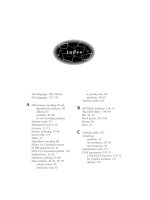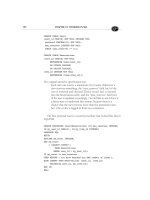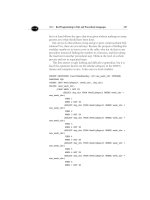SQL PROGRAMMING STYLE- P30 pps
Bạn đang xem bản rút gọn của tài liệu. Xem và tải ngay bản đầy đủ của tài liệu tại đây (63.36 KB, 5 trang )
72 CHAPTER 4: SCALES AND MEASUREMENTS
usually apply to discrete attributes. Nominal scales for continuous
attributes can be modeled but are rarely used.
4.1.2 Range
A scale also has other properties that are of interest to someone building
a database. First, scales have a range: What are the highest and lowest
values that can appear on the scale? It is possible to have a finite or an
infinite limit on either the lower or the upper bound. Overflow and
underflow errors are the result of range violations inside the database
hardware.
Database designers do not have infinite storage, so we have to pick a
subrange to use in the database when we have no upper or lower bound.
For example, few computer calendar routines will handle geologic time
periods, but then few companies have bills that have been outstanding
for that long either, so we do not mind.
4.1.3 Granularity, Accuracy, and Precision
Look at a ruler and a micrometer. They both measure length, using the
same scale, but there is a difference. A micrometer is more precise
because it has a finer granularity of units. Granularity is a static property
of the scale itself—how many notches there are on your ruler. In Europe,
all industrial drawings are done in millimeters; the United States has
been using 1/32nd of an inch.
Accuracy is how close the measurement comes to the actual value.
Precision is a measure of how repeatable a measurement is. Both depend
on granularity, but they are not the same things. Human nature says that
a number impresses according to the square of the number of decimal
places. Hence, some people will use a computer system to express things
to as many decimal places as possible, even when it makes no sense. For
example, civil engineering in the United States uses decimal feet for road
design. Nobody can build a road any more precisely than that, but many
civil engineering students turn in work that is expressed in ten-
thousandths of a foot. You don’t use a micrometer on asphalt! A database
often does not give the user a choice of precision for many calculations.
In fact, the SQL standards leave the number of decimal places in the
results of many arithmetic operations to be defined by the
implementation.
The ideas are easier to explain with handgun targets, which are scales
to measure the ability of the shooter to put bullets in the center of a
4.2 Types of Scales 73
target. A bigger target has a wider range compared with a smaller target.
A target with more rings has a higher granularity.
Once you start shooting, a group of shots that are closer together is
more precise because the shots were more repeatable. A shot group that
is closer to the center is more accurate because the shots were closer to
the goal. Notice that precision and accuracy are not the same thing! If I
have a good gun whose sights are off, I can get a tight cluster that is not
near the bull’s eye.
4.2 Types of Scales
The lack or presence of precision and accuracy determines the kind of
scale you should choose. Scales are either quantitative or qualitative.
Quantitative scales are what most people mean when they think of
measurements, because these scales can be manipulated and are usually
represented as numbers. Qualitative scales attempt to impose an order
on an attribute, but they do not allow for computations—just
comparisons.
4.2.1 Nominal Scales
The simplest scales are the nominal scales. They simply assign a unique
symbol, usually a number or a name, to each member of the set that they
attempt to measure. For example, a list of city names is a nominal scale.
Right away we are into philosophical differences, because many
people do not consider listing to be measurement. Because no clear
property is being measured, that school of thought would tell us this
cannot be a scale.
There is no natural origin point for a set, and likewise there is no
ordering. We tend to use alphabetic ordering for names, but it makes
just as much sense to use frequency of occurrence or increasing size or
almost any other attribute that does have a natural ordering.
The only meaningful operation that can be done with such a list is a
test for equality—“Is this city New York or not?”—and the answer will be
TRUE, FALSE, or UNKNOWN. Nominal scales are common in
databases because they are used for unique identifiers, such as names
and descriptions.
4.2.2 Categorical Scales
The next simplest scales are the categorical scales. They place an entity
into a category that is assigned a unique symbol, usually a number or a
74 CHAPTER 4: SCALES AND MEASUREMENTS
name. For example, the class of animals might be categorized as reptiles,
mammals, and so forth. The categories have to be within the same class
of things to make sense.
Again, many people do not consider categorizing to be measurement.
The categories are probably defined by a large number of properties, and
there are two potential problems with them. The first problem is that an
entity might fall into one or more categories. For example, a platypus is a
furry, warm-blooded, egg-laying animal. Mammals are warm-blooded
but give live birth and optionally have fur. The second problem is that an
entity might not fall into any of the categories at all. If we find a creature
with chlorophyll and fur on Mars, we do not have a category of animals
in which to place it.
The two common solutions are either to create a new category of
animals (monotremes for the platypus and echidna) or to allow an entity
to be a member of more than one category. There is no natural origin
point for a collection of subsets, and, likewise, there is no ordering of the
subsets. We tend to use alphabetic ordering for names, but it makes just
as much sense to use frequency of occurrence or increasing size or
almost any other attribute that does have a natural ordering.
The only meaningful operation that can be done with such a scale is a
test for membership—“Is this animal a mammal or not?”—which will
test either TRUE, FALSE, or UNKNOWN.
4.2.3 Absolute Scales
An absolute scale is a count of the elements in a set. Its natural origin is
zero, or the empty set. The count is the ordering (a set of five elements is
bigger than a set of three elements, and so on). Addition and subtraction
are metric functions. Each element is taken to be identical and
interchangeable. For example, when you buy a dozen Grade A eggs, you
assume that for your purposes any Grade A egg will do the same job as
any other Grade A egg. Again, absolute scales are in databases because
they are used for quantities.
4.2.4 Ordinal Scales
Ordinal scales put things in order but have no origin and no operations.
For example, geologists use a scale to measure the hardness of minerals
called Moh’s Scale for Hardness (MSH). It is based on a set of standard
minerals, which are ordered by relative hardness (talc = 1, gypsum = 2,
calcite = 3, fluorite = 4, apatite = 5, feldspar = 6, quartz = 7, topaz = 8,
sapphire = 9, diamond = 10).
4.2 Types of Scales 75
To measure an unknown mineral, you try to scratch the polished
surface of one of the standard minerals with it; if it scratches the surface,
the unknown is harder. Notice that I can get two different unknown
minerals with the same measurement that are not equal to each other
and that I can get minerals that are softer than my lower bound or
harder than my upper bound. There is no origin point, and operations
on the measurements make no sense (e.g., if I add 10 talc units, I do not
get a diamond).
Perhaps the most common use we see of ordinal scales today is to
measure preferences or opinions. You are given a product or a situation
and asked to decide how much you like or dislike it, how much you
agree or disagree with a statement, and so forth. The scale is usually
given a set of labels such as “strongly agree” through “strongly disagree,”
or the labels are ordered from 1 to 5.
Consider pairwise choices between ice cream flavors. Saying that
vanilla is preferred over wet leather in our taste test might well be
expressing a universal truth, but there is no objective unit of likeability
to apply. The lack of a unit means that such things as opinion polls that
try to average such scales are meaningless; the best you can do is a bar
graph of the number of respondents in each category.
Another problem is that an ordinal scale may not be transitive.
Transitivity
is the property of a relationship in which if
R(a, b)
and
R(b, c)
,
then
R(a, c)
. We like this property and expect it in the real world, where
we have relationships like “heavier than,” “older than,” and so forth. This
is the result of a strong metric property.
But an ice cream taster, who has just found out that the shop is out of
vanilla, might prefer squid over wet leather, wet leather over wood, and
wood over squid, so there is no metric function or linear ordering at all.
Again, we are into philosophical differences, because many people do
not consider a nontransitive relationship to be a scale.
4.2.5 Rank Scales
Rank scales have an origin and an ordering but no natural operations.
The most common example of this would be military ranks. Nobody is
lower than a private, and that rank is a starting point in your military
career, but it makes no sense to somehow combine three privates to get a
sergeant.
Rank scales have to be transitive: A sergeant gives orders to a private,
and because a major gives orders to a sergeant, he or she can also give
orders to a private. You will see ordinal and rank scales grouped together
in some of the literature if the author does not allow nontransitive
76 CHAPTER 4: SCALES AND MEASUREMENTS
ordinal scales. You will also see the same fallacies committed when
people try to do statistical summaries of such scales.
4.2.6 Interval Scales
Interval scales have a metric function, ordering, and meaningful
operations among the units but no natural origin. Calendars are the best
example; some arbitrary historical event is the starting point for the scale
and all measurements are related to it using identical units or intervals.
Time, then, extends from a past eternity to a future eternity.
The metric function is the number of days between two dates. Look
at the three properties: (1)
M(a, a)
= 0: there are zero days between today
and today; (2)
M(a, b)
=
M(b, a)
: there are just as many days from today
to next Monday as there are from next Monday to today; and (3)
M(a, b)
+
M(b, c)
=
M(a, c)
: the number of days from today to next Monday plus
the number of days from next Monday to Christmas is the same as the
number of days from today until Christmas. Ordering is natural and
strong: 1900-July-1 occurs before 1993-July-1. Aggregations of the basic
unit (days) into other units (weeks, months, and years) are also arbitrary.
Please do not think that the only metric function is simple math;
there are log-interval scales, too. The measurements are assigned
numbers such that ratios between the numbers reflect ratios of the
attribute. You then use formulas of the form (
c
×
m
^
d
), where
c
and
d
are
constants, to do transforms and operations. For example, density =
(mass/volume), fuel efficiency expressed in miles per gallon (mpg),
decibel scale for sound, and the Richter scale for earthquakes are
exponential, so their functions involve logarithms and exponents.
4.2.7 Ratio Scales
Ratio scales are what people think of when they think about a
measurement. Ratio scales have an origin (usually zero units), an
ordering, and a set of operations that can be expressed in arithmetic.
They are called ratio scales because all measurements are expressed as
multiples or fractions of a certain unit or interval.
Length, mass, and volume are examples of this type of scale. The unit
is what is arbitrary: The weight of a bag of sand is still weight whether it is
measured in kilograms or in pounds. Another nice property is that the
units are identical: A kilogram is still a kilogram whether it is measuring
feathers or bricks.









